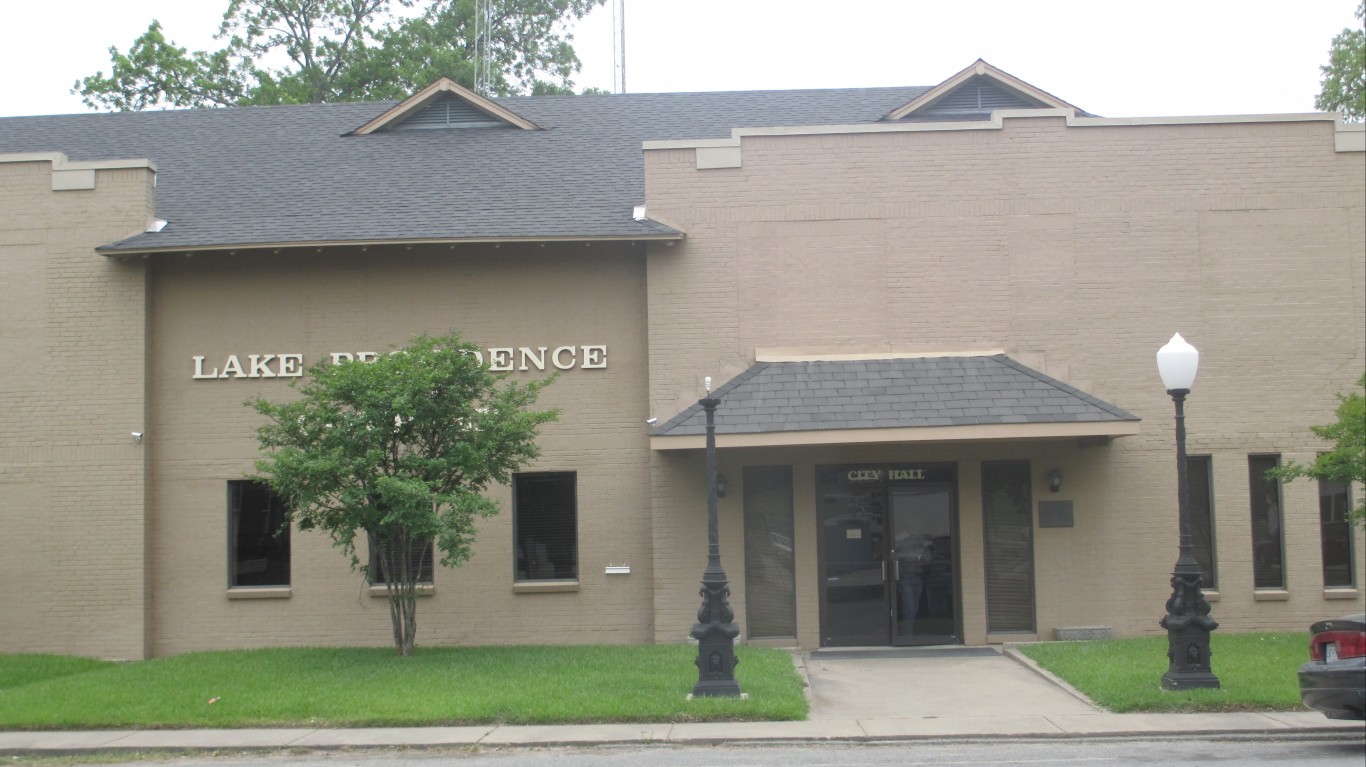
Eating a nutritious and well-balanced diet, exercising regularly, and abstaining from bad habits like smoking — while by no means a guarantee — greatly increase one’s odds of living a long and healthy life. While this should come as a surprise to no one, there are parts of the country where unhealthy lifestyles are relatively common. In these areas, the consequences are evident.
Americans who do not follow healthy lifestyle guidelines are often at increased risk of certain diseases and conditions that can be fatal, including heart disease, diabetes, and certain cancers. As a result, their odds of dying before age 75 increase, as does the day-to-day likelihood of poor physical or mental health.
24/7 Wall St. reviewed data on behaviors and outcomes in over 3,000 U.S. counties and county equivalents to identify the least healthy counties in the United States.
The overall health of a population is closely linked to certain social and economic conditions. A high uninsured rate is common in the counties on this list. Americans without health insurance are less likely to make regular doctor visits, receive treatments, and receive preventative care.
Partially because residents of most counties on this list are less likely to make regular doctor visits than the typical American, hospital visits for ailments that should have been treated in an outpatient facility are relatively common. All of the 20 least healthy counties in the United States have more preventable hospitalizations per capita than the national average of 4,520 per 100,000 Medicare enrollees. In some cases, the rate is almost triple.
Click here to read about the 20 least healthy counties in the United States.
To identify the 20 least healthy counties in the United States, 24/7 Wall St. reviewed county-level health data from 2019 County Health Rankings & Roadmaps, a Robert Wood Johnson Foundation and University of Wisconsin Population Health Institute joint program. Rankings are based on a composite score consisting of two categories of data: health outcomes and health factors. Health outcome measures include low birth weight, premature mortality, and average number of mentally unhealthy physically unhealthy days per month. Health factors include measures of that are linked to quality of life, including but not limited to smoking, obesity, physical inactivity, the number of health care providers per 100,000 people, excessive drinking, and the uninsured rate. The composite score was calculated using the national averages for each health outcome and factor, then combined into a composite score according to the CHR 2019 methodology. All 3,142 counties and county equivalents in the U.S. were considered.

20. Issaquena, Mississippi
> Obesity rate: 35.7%
> Smoking rate: 26.9%
> Uninsured rate: 17.8%
> Population: 1,339
Unhealthy behaviors in Issaquena, Mississippi, are common among adult residents. Some 32.3% of adults never exercise, and 26.9% smoke, both higher than the respective national shares of 22.0% and 17.0%. In addition, more than one in three adults are obese, higher than the national obesity rate of 29.0%.
Americans without health insurance and less likely to make regular doctor visits and receive preventative medical care. In Issaquena County, 17.8% of the population does not have health insurance, a significantly higher uninsured rate than the national rate of 10.0%.
[in-text-ad]

19. McCreary, Kentucky
> Obesity rate: 35.8%
> Smoking rate: 30.8%
> Uninsured rate: 7.8%
> Population: 17,465
Adverse health outcomes are more prevalent in McCreary County, Kentucky, compared to the United States as a whole. The adult obesity rate of 35.8% is higher than the national rate of 29.0%. Also, more than one in three county adults report being in poor or fair health, the 13th highest share of U.S. counties and more than double the comparable nationwide share of 16.0%. In addition, the number of preventable hospitalizations, which refers to the number of diagnoses that can be treated in outpatient settings, per 100,000 Medicare enrollees is 6,860, higher than the national average of 4,520.

18. Lowndes, Alabama
> Obesity rate: 46.2%
> Smoking rate: 22.4%
> Uninsured rate: 11.4%
> Population: 10,076
In Lowndes, Alabama, poor health outcomes are far more common than they are across the state and the nation as a whole. For example, the adult obesity rate of 46.2% is the fourth highest among all 3,142 U.S. counties and county equivalents. Additionally, the premature mortality rate of 689 deaths before the age of 75 per 100,000 people is also among the highest in the entire country.
Unhealthy habits may help explain some of the poor health outcomes. More than one in five county adults smoke, compared to a national smoking rate of 17.0%, and nearly one in three adults do not exercise, compared to a U.S. inactivity rate of 22.0%.

17. Clay, Kentucky
> Obesity rate: 39.2%
> Smoking rate: 29.3%
> Uninsured rate: 8.0%
> Population: 20,366
Clay is one of the three Kentucky counties to rank among the 20 least healthy U.S. counties. In Clay County, 29.3% of adults smoke, well above the 17.0% national smoking rate. Additionally, despite widespread access to places like parks and recreation centers, 34.3% of adults in the county get no exercise beyond getting up and going to work. Nationwide, only 22.0% of adults lead similarly sedentary lives.
[in-text-ad-2]

16. Madison, Louisiana
> Obesity rate: 39.6%
> Smoking rate: 28.7%
> Uninsured rate: 10.9%
> Population: 11,316
Madison’s adult smoking rate of 28.7% is significantly higher than the 17.0% national rate and is among the 30 worst of all 3,142 U.S. counties and county equivalents. The county’s adult obesity rate of 39.6% is also higher than the national rate of 29.0%. Obesity and smoking are both known risk factors of numerous diseases, including diabetes and heart conditions, and the parish’s high share of both may explain in part other poor health outcomes. For example, 31.9% of adults in Madison Parish are in fair or poor health nearly double the 16.0% share of adults nationwide.

15. Mingo, West Virginia
> Obesity rate: 38.3%
> Smoking rate: 24.8%
> Uninsured rate: 7.6%
> Population: 24,127
Mingo ranks almost at the bottom in West Virginia and 15th worst among all U.S. counties and county equivalents when it comes to health as measured by local behaviors and outcomes. The number of preventable hospital stays, 16,453 preventable hospitalizations per 100,000 Medicare enrollees in the county, is the third highest nationwide. In addition, the premature mortality rate is also among the highest in the country at 687 deaths before age 75 per 100,000 people. Mingo County adult residents report an average of 5.6 mentally unhealthy days a month, the eighth highest of all U.S. counties, and 5.9 physically unhealthy days a month, the 14th highest.
[in-text-ad]

14. Lake, Tennessee
> Obesity rate: 35.0%
> Smoking rate: 26.6%
> Uninsured rate: 11.2%
> Population: 7,468
Smoking is an unhealthy behavior that is common among adult residents of the Lake County. More than one in four adults are smokers, compared to the U.S. adult smoking rate of 17.0%. The county has some of the highest shares of preventable hospitalizations in the United States, at 11,277 per 100,000 Medicare enrollees. This is more than double the national average of 4,520 preventable hospitalizations per 100,000 people, and among the worst in the country.

13. Holmes, Mississippi
> Obesity rate: 44.8%
> Smoking rate: 27.1%
> Uninsured rate: 15.7%
> Population: 17,739
The adult smoking, obesity, and physical inactivity rates in Holmes, Mississippi, are some of the highest in the country. Smoking, obesity, and sedentary lifestyle are all factors known to increase the risk of cancer, diabetes, and other chronic conditions. About 35.1% of county adults report being in poor or fair health, the 10th largest share in the United States and well above the 16.0% of adults reporting suboptimal health across the country.
Holmes County residents are also less likely than most Americans to make regular doctor visits and receive preventative care, as evidenced by a high uninsured rate. Some 15.7% of Holmes County residents do not have health insurance, much higher than the national uninsured rate of 10.0%.

12. Union, Florida
> Obesity rate: 38.2%
> Smoking rate: 24.9%
> Uninsured rate: 11.5%
> Population: 15,517
One in four adults in Union County, Florida, smoke, much higher than the national smoking rate of 17.0%. About 38.2% of county adults are obese, compared to 29.0% across the county. Such unhealthy behaviors and outcomes may partly contribute to the county’s high premature mortality rate of 937 deaths before age 75 per 100,000 people, the fourth highest of any county or county equivalent in the United States.
The county’s premature death rate is also likely partially attributable to the large share of residents who may need medical treatment, but do not seek it. Some 11.5% of residents do not have health insurance, higher than the national uninsured rate of 10.0%.
[in-text-ad-2]

11. Jefferson, Mississippi
> Obesity rate: 49.5%
> Smoking rate: 26.4%
> Uninsured rate: 17.1%
> Population: 7,262
Jefferson County, Mississippi, has the highest share of adults who are obese in the country. Nearly half of the adult population in Jefferson County, Mississippi are obese the largest share of any county or county equivalent in the United States. Unhealthy habits, such as smoking, are also common in Jefferson County. More than one in every four adult residents are smokers. For reference, the U.S. adult smoking rate is 17.0%.

10. Quitman, Mississippi
> Obesity rate: 41.1%
> Smoking rate: 26.1%
> Uninsured rate: 16.5%
> Population: 7,269
The adult smoking, obesity, and inactivity rates in Quitman, Mississippi, are some of the highest in the country. Smoking, obesity, and sedentary lifestyle are all factors known to increase the risk of cancer, diabetes, and other chronic conditions. More than one in three adults in the county report being in poor or fair health, the 15th highest share of any county or county equivalent in the United States. For reference, 16.0% of adults across the country report being in fair or poor health.
A far larger than typical share of Quitman County residents lack health insurance. The county’s 16.5% uninsured rate is well above the national uninsured rate of 10.0%.
[in-text-ad]

9. Corson, South Dakota
> Obesity rate: 40.3%
> Smoking rate: 33.1%
> Uninsured rate: 18.7%
> Population: 4,203
Corson is one of four counties in South Dakota to rank among the least healthy counties in the United States. Residents of Corson County are more likely to engage in unhealthy behaviors such as smoking. Nearly one in three adult residents smoke, the 10th highest smoking rate in the country. For reference, 17.0% of adults nationwide smoke. Access to healthy foods, which is measured by how far people live from a grocery store or a supermarket, is limited in the county. This may help explain the high obesity rate, which at 40.3% is significantly higher than the U.S. obesity rate of 29.0%.

8. East Carroll, Louisiana
> Obesity rate: 37.8%
> Smoking rate: 32.0%
> Uninsured rate: 11.1%
> Population: 7,126
Unhealthy habits and outcomes are common among adult residents of East Carroll, Louisiana. The are 17,731 preventable hospitalizations per 100,000 Medicare enrollees, about four times the national average of 4,520 per 100,000 and the second highest in the United States. Nearly one in three adults in the parish smoke, the 13th highest smoking rate in the country and nearly double the comparable nationwide rate of 17.0%.

7. Owsley, Kentucky
> Obesity rate: 37.8%
> Smoking rate: 26.7%
> Uninsured rate: 7.0%
> Population: 4,435
About 26.7% of Owsley county adult residents smoke, significantly higher than the national adult smoking rate of 17.0%. In addition to smoking, adult residents are also more likely to be obese and lead sedentary lives compared to adults nationwide. Smoking, not exercising, and obesity may help explain the county’s high premature mortality rate. At 930 deaths before age 75 per 100,000 people, it is the fifth highest among all U.S. counties and county equivalents. Owsley also ranks high in the average number of physically unhealthy days adults report a month, 5.6 compared to a U.S. average of 3.7.
[in-text-ad-2]

6. Kusilvak, Alaska
> Obesity rate: 26.9%
> Smoking rate: 42.8%
> Uninsured rate: 22.2%
> Population: 8,202
More than one in five adults in Kusilvak, Alaska, do not have health insurance, more than double the national uninsured rate of 10.0%. People with health insurance are more likely to make regular doctor visits and receive diagnosis and treatment for different ailments, from bacterial infections to chronic conditions and other diseases, than those without insurance. The county also has the highest share of adult smokers in the entire country, at 42.8%. Kusilvak adult residents also report 7.2 days of physically unhealthy days per month average, the most of any U.S. county or county equivalent.

5. Todd, South Dakota
> Obesity rate: 38.6%
> Smoking rate: 39.1%
> Uninsured rate: 16.9%
> Population: 10,065
Adult residents of Todd, South Dakota, are more likely to report being in poor or fair health than adults nationwide. Almost one in three adults feel in suboptimal health, compared to 16.0% across the United States. Residents report an average of 5.9 physically unhealthy days a month, more than the U.S. average of 3.7 days.
High smoking and obesity rates may help explain the unhealthy outcomes. About 39.1% of adults smoke, the third highest rate in the country, more than double the national smoking rate of 17.0%. Also, about 38.6% of adults are obese, compared to 29.0% across the country.
[in-text-ad]

4. Sioux, North Dakota
> Obesity rate: 35.4%
> Smoking rate: 38.3%
> Uninsured rate: 13.6%
> Population: 4,376
Sioux County is located in the northernmost portion of the Standing Rock Reservation. The county’s population identifies primarily as Native American. The county’s 38.3% adult smoking rate is the fourth highest in the United States, and well more than double the national smoking rate of 17.0%. Sioux’s annual premature mortality rate of 1,089 deaths before age 75 per 100,000 people is the third worst in the country.

3. McDowell, West Virginia
> Obesity rate: 45.8%
> Smoking rate: 27.9%
> Uninsured rate: 10.0%
> Population: 18,456
McDowell County adult residents report an average of 6.0 mentally unhealthy days a month, the most of any U.S. county, and 6.4 physically unhealthy days a month, the third most. The high adult obesity rate may be a factor. At 45.8%, it is the second highest among the 20 counties and county equivalents on our list and the sixth highest nationwide.
Additionally, nearly one in three adults in the county report being in poor of fair health, among the highest shares nationwide and more than double the U.S. share of 16.0% of adults who report suboptimal health.

2. Buffalo, South Dakota
> Obesity rate: 41.0%
> Smoking rate: 37.0%
> Uninsured rate: 17.9%
> Population: 1,999
Adults in Buffalo County, South Dakota, are more likely to smoke and be uninsured than adults nationwide. The adult smoking rate of 37.0% is more than double the U.S. smoking rate of 17.0%. Additionally, about 17.9% of residents do not have health insurance coverage, significantly higher than the national uninsured rate of 10.0%. In addition to high smoking rates and low health insurance coverage, the county’s.
High smoking and uninsured rates partially explain the prevalence of preventable and premature deaths in Buffalo County. There are 1,146 deaths before age 75 per 100,000 people annually in Buffalo County, the highest premature mortality rate of any U.S. county or county equivalent.
[in-text-ad-2]

1. Oglala Lakota, South Dakota
> Obesity rate: 40.5%
> Smoking rate: 41.2%
> Uninsured rate: 15.5%
> Population: 14,354
Oglala Lakota ranks as the least healthy county of all the more than 3,000 counties and county equivalents in the United States due to numerous factors, including a 41.2% adult smoking rate — the second highest in the country. Smoking is a known risk factor for many diseases and premature death.
Access to nutritious and balanced diet, which is important to maintaining good health, is very limited in the county, as many county residents do not live near a grocery store. A high food insecurity rate may explain the high obesity rate — 40.5% compared to a U.S. average of 29.0%.
Are You Ahead, or Behind on Retirement? (sponsor)
If you’re one of the over 4 Million Americans set to retire this year, you may want to pay attention. Many people have worked their whole lives preparing to retire without ever knowing the answer to the most important question: are you ahead, or behind on your retirement goals?
Don’t make the same mistake. It’s an easy question to answer. A quick conversation with a financial advisor can help you unpack your savings, spending, and goals for your money. With SmartAsset’s free tool, you can connect with vetted financial advisors in minutes.
Why wait? Click here to get started today!
Thank you for reading! Have some feedback for us?
Contact the 24/7 Wall St. editorial team.
 24/7 Wall St.
24/7 Wall St. 24/7 Wall St.
24/7 Wall St. 24/7 Wall St.
24/7 Wall St. 24/7 Wall St.
24/7 Wall St.


